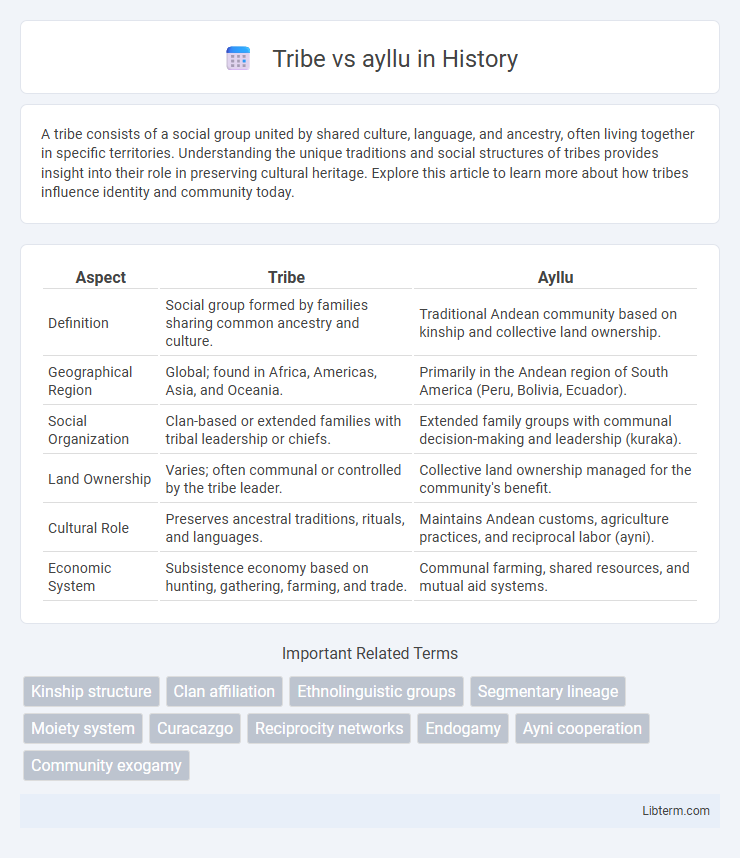A tribe consists of a social group united by shared culture, language, and ancestry, often living together in specific territories. Understanding the unique traditions and social structures of tribes provides insight into their role in preserving cultural heritage. Explore this article to learn more about how tribes influence identity and community today.
Table of Comparison
| Aspect | Tribe | Ayllu |
|---|---|---|
| Definition | Social group formed by families sharing common ancestry and culture. | Traditional Andean community based on kinship and collective land ownership. |
| Geographical Region | Global; found in Africa, Americas, Asia, and Oceania. | Primarily in the Andean region of South America (Peru, Bolivia, Ecuador). |
| Social Organization | Clan-based or extended families with tribal leadership or chiefs. | Extended family groups with communal decision-making and leadership (kuraka). |
| Land Ownership | Varies; often communal or controlled by the tribe leader. | Collective land ownership managed for the community's benefit. |
| Cultural Role | Preserves ancestral traditions, rituals, and languages. | Maintains Andean customs, agriculture practices, and reciprocal labor (ayni). |
| Economic System | Subsistence economy based on hunting, gathering, farming, and trade. | Communal farming, shared resources, and mutual aid systems. |
Defining "Tribe" and "Ayllu": Conceptual Foundations
A tribe is a social group characterized by shared language, culture, and kinship, often organized around a common ancestry and political structure, typically found in various indigenous and traditional societies worldwide. An ayllu, specific to Andean cultures, particularly the Quechua and Aymara peoples, functions as a collective community unit based on kinship and mutual obligations for land use, agriculture, and social welfare. Both concepts emphasize communal ties but differ in their cultural contexts, with tribes often broader in sociopolitical organization and ayllus deeply integrated into indigenous Andean cosmology and reciprocal economic practices.
Historical Origins of Tribes and Ayllus
Tribes originated as kin-based social groups structured around extended family networks and common ancestry, often found in diverse cultures across Africa, Asia, and the Americas. Ayllus, indigenous to the Andean regions of South America, particularly among the Quechua and Aymara peoples, functioned as collective community units centered on agricultural cooperation and shared land management. Both tribes and ayllus represent foundational social organizations, with tribes emphasizing lineage and political alliances, while ayllus prioritized communal labor and reciprocity rooted in ancestral ties.
Geographic Distribution: Where Do Tribes and Ayllus Exist?
Tribes are predominantly found across Africa, Asia, and the Americas, often inhabiting regions such as the Amazon rainforest, African savannas, and Himalayan foothills. Ayllus are indigenous communities primarily located in the Andean highlands of Peru and Bolivia, functioning as traditional socio-economic units among Quechua and Aymara peoples. Geographic distribution reflects adaptation to diverse environments, with tribes spanning vast territories while ayllus maintain localized, agrarian settlements in mountainous regions.
Social Structure Comparison: Tribe vs Ayllu
Tribes are typically organized around kinship groups with a flexible leadership structure and emphasis on alliances among clans, whereas ayllus function as extended family units rooted in communal land ownership and collective labor in Andean cultures. Tribal social systems often feature individual households with varying degrees of autonomy, while ayllus emphasize shared responsibilities and resource distribution governed by consensus and reciprocity. The ayllu's integration of social, economic, and spiritual roles contrasts with tribes, where roles may be more segmented and leadership less centralized.
Leadership and Decision-Making in Tribes and Ayllus
Tribe leadership often centers around a chief or council whose decisions reflect the collective interests of the group, balancing tradition with the needs of members. Ayllu leadership integrates community consensus rooted in ancestral customs, with decisions made through collective deliberation and mutual aid principles. Both systems emphasize communal well-being, yet tribes lean toward hierarchical guidance while ayllus prioritize egalitarian collaboration in governance.
Economic Organization and Resource Sharing
Tribes typically feature decentralized economic organization with resource sharing based on kinship and reciprocal relationships, where individual families manage their own production but support group needs through mutual aid. Ayllus demonstrate a more collective economic structure, emphasizing communal land ownership and coordinated agricultural labor, ensuring equitable distribution of resources among members. This shared management system in ayllus enhances social cohesion and sustainability by integrating economic activities with cultural and spiritual practices.
Role of Kinship and Family Ties
In indigenous societies, kinship and family ties form the cornerstone of both tribes and ayllus, but they manifest differently in social organization and governance. Tribes typically emphasize broader clan-based affiliations with flexible kinship networks that facilitate collective decision-making and resource sharing. Ayllus, particularly among Andean communities, are tightly knit kin groups structured around ancestral lineage, fostering communal land ownership and reciprocal labor obligations that reinforce social cohesion and identity.
Cultural Traditions and Collective Identity
Tribes typically emphasize kinship ties and shared customs that shape their collective identity, often maintaining oral traditions, rituals, and social structures unique to their ethnic group. Ayllus, primarily found in Andean cultures, integrate agricultural cooperation and reciprocal labor systems known as "mink'a" or "ayni," reinforcing community solidarity and resource sharing. The cultural traditions of ayllus are deeply intertwined with ancestral land stewardship and spiritual beliefs, creating a collective identity rooted in both social and ecological interdependence.
Adaptation and Transformation Over Time
Tribes represent flexible social units that adapt to changing environmental and economic conditions through shifting alliances and resource management strategies. Ayllus, indigenous to Andean cultures, emphasize collective land stewardship and inherited kinship structures that transform gradually to sustain communal resilience. Both systems illustrate dynamic adaptation, with tribes often responding rapidly to external pressures while ayllus evolve through intergenerational cultural continuity.
Contemporary Relevance: Tribe vs Ayllu in Modern Society
Tribes in modern society often refer to social groups bonded by shared ethnicity or culture, emphasizing individual identity within larger national frameworks. Conversely, ayllus, rooted in Andean indigenous traditions, maintain collective land ownership and communal responsibilities, promoting sustainable living and social cohesion. Understanding these distinctions aids in preserving indigenous governance models and addressing contemporary issues such as land rights and cultural resilience.
Tribe Infographic

 libterm.com
libterm.com